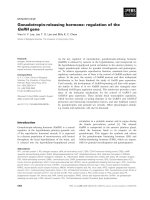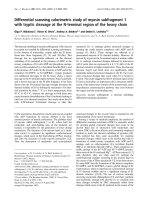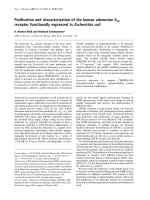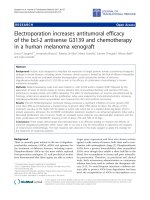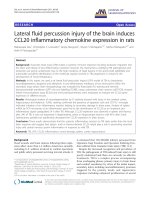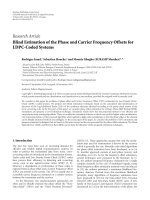Báo cáo toán học: "Differential display identifies overexpression of the USP36 gene, encoding a deubiquitinating enzyme, in ovarian cancer" pot
Bạn đang xem bản rút gọn của tài liệu. Xem và tải ngay bản đầy đủ của tài liệu tại đây (677.37 KB, 10 trang )
Int. J. Med. Sci. 2008, 5
133
International Journal of Medical Sciences
ISSN 1449-1907 www.medsci.org 2008 5(3):133-142
© Ivyspring International Publisher. All rights reserved
Research Paper
Differential display identifies overexpression of the USP36 gene, encoding a
deubiquitinating enzyme, in ovarian cancer
Jianduan Li
1
, Lisa M. Olson
1,2
, Zhengyan Zhang
1
, Lina Li
1,3
, Miri Bidder
1
, Loan Nguyen
1
, John Pfeifer
4
, Janet
S. Rader
1
1. Department of Obstetrics and Gynecology, Division of Gynecologic Oncology, Washington University School of Medicine,
St. Louis, MO 63110, USA
2. Abbott Bioresearch Center, Worcester, MA, USA
3. Laboratory of Biochemical Genetics, National Heart, Lung, and Blood Institute, NIH, Bethesda, USA
4. Department of Pathology, Washington University School of Medicine, St. Louis, MO 63110, USA
Correspondence to: Janet S. Rader, MD, Professor, Department of Obstetrics and Gynecology, Division of Gynecologic Oncology,
Department of Genetics, Washington University School of Medicine, Box #8064, 4911 Barnes-Jewish Hospital Plaza, St. Louis, MO
63110. Phone: 314-362-3181; fax 314-362-2893; email:
Received: 2007.08.27; Accepted: 2008.06.05; Published: 2008.06.06
Objectives. To find potential diagnostic markers or therapeutic targets, we used differential display technique to
identify genes that are over or under expressed in human ovarian cancer.
Methods. Genes were initially identified by differential display between two human ovarian surface epithelium
cultures and two ovarian cancer cell lines, A2780 and Caov-3. Genes were validated by relative quantitative
RT-PCR and RNA in situ hybridization.
Results. Twenty-eight non-redundant sequences were expressed differentially in the normal ovarian epithelium
and ovarian cancer cell lines. Seven of the 28 sequences showed differential expression between normal ovary
and ovarian cancer tissue by RT-PCR. USP36 was over-expressed in ovarian cancer cell lines and tissues by
RT-PCR and RNA in situ hybridization. Northern blot analysis and RT-PCR revealed two transcripts for USP36 in
ovarian tissue. The major transcript was more specific for ovarian cancer and was detected by RT-PCR in 9/9
ovarian cancer tissues, 3/3 cancerous ascites, 5/14 (36%) sera from patients with ovarian cancer, and 0/7 sera
from women without ovarian cancer.
Conclusion. USP36 is overexpressed in ovarian cancer compared to normal ovary and its transcripts were
identified in ascites and serum of ovarian cancer patients.
Key words: ovarian cancer; biological markers; ubiquitin specific peptidase 36 (USP36); deubiquitinating enzyme
Introduction
Ovarian cancer, the most fatal gynecological
cancer, is ranked fourth in overall cancer mortality
among women in the United States, causing ~16,000
deaths per year [1]. A woman’s estimated risk of
developing ovarian cancer in her lifetime is 1 in 70 or
1.4%. Unfortunately, no fully effective mass screening
method for early ovarian cancer has yet been
developed. The currently available methods, such as
abdominal and transvaginal ultrasonography, color
flow Doppler, and CA-125, are not specific enough for
detecting early, treatable ovarian cancer through
population screening [2]. Therefore, the disease is
detected at an advanced stage in most patients, being
confined to the ovaries at diagnosis in fewer than 30%
of cases.
Epithelial ovarian cancer develops from a clone of
cells [3], which suggests that early stages of the disease
could be detected if specific tumor markers expressed
at early stages could be identified. To find potential
diagnostic markers for early ovarian cancer, we used
differential display previously described [4] for
identifying key genes that were uniquely
overexpressed or silenced in ovarian cancer compared
with normal cells. As more than 85% of human ovarian
cancers are thought to be derived from ovarian surface
epithelium (OSE) [5], we performed differential
display to compare gene expression patterns in two
cultured OSE cells and two human ovarian cancer cell
lines, A2780 and Caov-3. We used relative quantitative
RT-PCR and RNA in situ hybridization techniques to
further evaluate the differentially expressed genes.
USP36 was confirmed over-expressed in ovarian
cancer cell lines and tissues. The USP36 predominant
transcript was further characterized in multiple
human tissues, cancerous ascites, and sera from
women with and without ovarian cancer.
In eukaryotic cells, ubiquitination and
Int. J. Med. Sci. 2008, 5
134
deubiquitination regulate a number of biological
processes by balancing cellular protein degradation.
This post-translational modification is a dynamic and
reversible process controlled by the coordinate action
of multiple ubiquitin-conjugating and
deubiquitylating enzymes. USP36 is one of the
deubiquitinating (DUB) enzymes and belongs to
ubiquitin-specific processing proteases (USP). USP
removes ubiquitin from specific protein substrates and
allow protein salvage from proteasome degradation,
regulation of protein localization or activation [6].
Previous studies demonstrated that USP36 has DUB
activity both in vivo and in vitro [7, 8].
Materials and methods
Cell cultures and tissue samples
Tissue samples from normal ovaries and ovarian
cancers were obtained from women undergoing
oophorectomies. RNA from other human tissues was
obtained from the Tissue Procurement Core at the
Siteman Cancer Center. The study was approved by
the Human Studies Committee of Washington
University in St. Louis.
Human OSE cells were collected according to the
method described by Kruk et al [9] and cultures were
maintained in a mixture of Medium 199 with Earle’s
balanced salt solution (Sigma, St. Louis, MO) and
MCDB105 (Sigma, St. Louis, MO) (1:1, pH 7.3)
supplemented with 15% FBS (medium 199/105/15%
FBS) and 2 mM L-glutamine. The medium contained
10
3
IU/ml of penicillin and 10
3
μg/ml of streptomycin
and fungizone (250 ng/ml) for the first week. Cells
were plated onto a T25 polystyrene flask with 5 ml of
medium and incubated undisturbed at 37°C in 5%
CO
2
/air for 48 hours. The old medium, which
contained blood and debris, was replaced with fresh
prewarmed (37°C) medium. Subsequently, the culture
medium was changed every 3-4 days as needed. When
the culture was confluent, the cells were subcultured
with trypsin/EDTA (Life Technologies, Gaithersburg,
MD).
To characterize the cultured cells, we added 3-4
drops (50-100 μl) of prewarmed medium into each well
of a microscope slide well chamber (16 wells/slide).
Two drops of trypsin/EDTA/cell mixture were seeded
into each well. The medium was changed every 3-4
days until the cells were confluent. Then cells were
fixed in methanol/acetone and stained for cytokeratin
and vimentin using anti-cytokeratin AE1/AE3
(Boehringer Mannheim, Indianapolis, IN) and
anti-vimentin (Boehringer Mannheim, Indianapolis,
IN) following the manufacturer’s instructions.
To propagate the cells and extract their RNA, we
placed the remaining trypsin/EDTA/cell mixture in a
T75 polystyrene flask and added 10 ml of prewarmed
(37°C) medium. The medium was changed on the next
day to remove debris and then changed every 3-4 days.
When the cells in the flask were confluent, they were
trypsinized and RNA was extracted.
The A2780 cell line was cultured in RPMI 1640
medium. The Caov-3 cell line was cultured in
Dulbecco's modified Eagle's medium (DMEM). Both
media were supplemented with 10% FBS, 2 mM
L-glutamine, 10
3
IU/ml of penicillin and 10
3
μg/ml of
streptomycin. The cell lines were cultured in 5% CO
2
at
37°C.
Differential display
Total cellular RNA was isolated from the cell
lines by the guanidinium isothiocyanate method [10].
Contaminating DNA was removed with the
MessageClean
TM
Kit (GenHunter Co., Nashville, TN).
Differential display technique was first described by
Liang and Pardee in 1992[4]. Since then the technique
has been applied in numerous studies. We
performanced the differential display using the
RNAimage
TM
kit (GenHunter Co. Nashville, TN),
following the manufacturer’s instructions.
Total RNA was reverse transcribed using the
primer H-T11A (5'-AAGCTTTTTTTTTTTA-3'),
H-T11G (5'-AAGCTTTTTTTTTTTG-3'), or H-T11C
(5'-AAGCTTTTTTTTTTTC-3'). The product was
amplified by PCR using one of the primer pairs labeled
with alpha-[
35
S]-dATP. Overall, 24 primer pairs were
used for PCR, including combinations of each of the
above three primers with
H-AP49 (5'-AAGCTTTAGTCCA-3'),
H-AP50 (5'-AAGCTTTGAGACT-3'),
H-AP51 (5'-AAGCTTCGAAATG-3'),
H-AP52 (5'-AAGCTTGACCTTT-3'),
H-AP53 (5'-AAGCTTCCTCTAT-3'),
H-AP54 (5'-AAGCTTTTGAGGT-3'),
H-AP55 (5'-AAGCTTACGTTAG-3'), or
H-AP56 (5'-AAGCTTATGAAGG-3').
All PCR products were electrophoresed in parallel on
extended-format denaturing 6% polyacrylamide gel
and displayed by autoradiography.
cDNA cloning and sequencing
PCR products of the RNAs that were found to be
differentially expressed between OSE cell lines and
ovarian cancer cell lines were cut out from a
polyacrylamide gel, re-amplified with the same primer
pair, purified on agarose gels using the QIAquick Gel
Extraction Kit (QIAGEN, Valencia, CA), and then
cloned into the pCR-TRAP Cloning System
TM
(GenHunter Co., Nashville, TN). The inserts of clones
were sequenced using either the Lgh and or Rgh
primer flanking the cloning site. All sequencing
Int. J. Med. Sci. 2008, 5
135
reactions were performed ustilizing ABI PRISM
TM
BigDye
TM
Terminator Cycle Sequencing Ready
Reaction Kit (Perkin Elmer, Foster City, CA).
RT-PCR
Relative quantitative RT-PCR was performed
according to the method of Nicoletti and Sassy-Prigent
[11], with some modification. RNA samples were
diluted to 1 μg/4 μl (assessed by OD
260
). One μg of
each mixed RNA (normal and cancer) sample was
used for reverse transcription in a reaction mixture
whose final volume was 20 μl. The mixture contained 1
μg of oligo(dT)
15
, 200 U of MMLV reverse
transcriptase, 50 mM Tris-HCl (pH 8.3), 75 mM KCl, 3
mM MgCl
2
, 10 mM dithiothreitol (DTT), 20 U RNase
inhibitor (Promega, Madison, WI), and 0.5 mM each of
dNTP and 0.1% DEPC (Sigma, St. Louis, MO). It was
incubated at 37°C for 60 min.
The primers were designed using the Primer 3
program (
primer/primer3_www.cgi). Multiplex PCR was
performed in a total volume of 20 μl that contained 0.5
μM of each primer, 500 μM each of dNTP, 10 mM
Tris-HCl (pH 8.3), 50 mM KCl, 6 mM MgCl
2
and 2.5 U
of AmpliTaq DNA Polymerase (Perkin-Elmer,
Norwalk, CT). An endogenous housekeeper gene,
glyceraldehyde-3-phosphate dehydrogenase (GAPDH) was
used as an internal standard to correct for tube-to-tube
variations in amplification efficiency. The PCR
thermocycles were: 4 min at 94°C, (1.5 min at 94°C, 2
min at 55°C, and 3 min at 72°C)
20
, and 10 min at 72°C.
A minus RT-PCR reaction was included for every RNA
sample to confirm the absence of contaminating DNA.
Quantitative data on the PCR products were
acquired by digitizing photographs of ethidium
bromide-stained agarose gel into gray-scale images
using the public NIH Image 1.71 program and by the
Wave DNA Fragment Analysis System
(Transgenomic, Omaha, NE).
RNA in situ hybridization
RNA in situ hybridization was performed using a
digoxigenin (DIG) labeled riboprobe. Sense and
antisense riboprobes were synthesized separately and
labeled in total volume of 20 µl. The reaction mixture
contained 1 x transcription buffer, 1 x DIG RNA
labeling mixture from the DIG Genius 4 RNA Labeling
Kit (Boehringer Mannheim, Indianapolis, IN), 5 mM
DTT, 20 U of RNase inhibitor (Promega, Madison, WI),
40 U of T7 or SP6 RNA polymerase (Promega,
Madison, WI), and 60 ng of linearized DNA templates.
The templates were generated from the PCR products
amplified using T7 and SP6 primer (GenHunter Co.,
Nashville, TN) from IMAGE clone 2400019. The
generated antisense probe for USP36 is 267bp (5’-
ggatccatttaggtgacactatagaagtacctgaaaggaagcttttttttttcg
aggatttcctgtatttattaagttacaagttggcaggcacagcttgagcaacat
agaaaagtaatcttcttgagttatacaatcatttaaattccaaagcactcacaa
aattgagcaaacaaagccactatttgcatatttgggaaaggaaacatattgct
aacgtaagcttcctgaatccttcatggcctatagtgagtcgtattagaattc-3’
). The synthesized riboprobe was precipitated by
ethanol and verified by RNA electrophoresis.
Formalin-fixed paraffin-embedded tissue slides were
deparaffinized in Hemo-De (Fisher Scientific,
Pittsburgh, PA), rehydrated in serially diluted ethanol
(100%, 95%, 70%, 50%, and 30%), digested in 2 µg/ml
proteinase K at 37ºC for 30 min, and then rinsed 3
times in PBT (PBS containing 0.1% Tween 20 and 0.1%
DEPC). The pretreated slides were hybridized at 55ºC
overnight in a buffer containing 50% formamide, 5 x
SSC, 100 µg/ml Salmon Sperm DNA, 100 µg/ml
heparin, 0.1% Tween 20, 1 x Denhardt’s medium, 0.1%
CHAPS, 5 mM EDTA, and ~16 µg/ml DIG-labeled
riboprobe. After the slides were rinsed with 0.1 x SSC
and blocked with blocking buffer (5% sheep serum, 2
mg/ml BSA, and 1% DMSO in PBT), DIG-labeled
riboprobe was detected with anti-digoxigenin-AP, Fab
fragments (Boehringer Mannheim, Indianapolis, IN),
according to manufacture’s instructions.
Northern blot
mRNA was extracted by the Messenger RNA
standard isolation kit (Sigma, St. Louis, MO), and total
RNA was extracted by the ToTALLY RNA kit
(Ambion, Austin, TX). The products were
electrophoresed on 1.5% formaldehyde/1% agarose
gel with RNA Milennium
TM
Size Marker (Ambion,
Austin, TX). The RNA was transferred from the gel to
BrightStar-Plus
TM
Membranes (Ambion, Austin, TX)
and cross-linked onto the membrane with UV.
Single-strand DNA probes labeled with
32
P dCTP were
made by asymmetric PCR, using antisense primer and
same template as in RNA in situ hybridization. The
synthesized probe was purified on a centrifuge
column, and its specific activity was measured by
liquid scintillation analysis. The probe for USP36 is
130bp (5’- ttacaagttggcaggcacagcttgagcaacatagaaaagt
aatcttcttgagttatacaatcatttaaattccaaagcactcacaaaattgagca
aacaaagccactatttgcatatttgggaaaggaaa-3’). The
membrane was hybridized in buffer containing 1.6 x
10
7
cpm/ml probe and 6.0 x 10
4
cpm RNA
Milennium
TM
Size Marker (Ambion, Austin TX) at
50ºC for 16 h. The membrane was rinsed with low
stringency solution 2 x SSC and 0.1% SDS at 50ºC for 15
min and then autoradiographed at -70°C with
intensifier screen.
Isolation of RNA from ascites and serum
Serum was isolated and stored at -70°C until
processed. Ascites was collected at surgery and
Int. J. Med. Sci. 2008, 5
136
centrifuged at 4°C for 5 minutes at 150g. The
supernatant was removed and stored at -70°C until
processed. Isolation of RNA was preformed using
TRIzol® LS Reagent (Invitrogen Corporation,
Carlsbad, CA) or magnetic bead method - Ambion’s
MagMax
TM
technology (Ambion, Inc., Austin, TX)
following manufactures’ protocol. DNA and RNA
input levels ranging from 20 copies to 25x10
6
copies
can be quantitatively recovered from plasma, serum,
and milk (MagMax
TM
manual). The concentration and
purity of RNA were determined by using the
Nanodrop® ND-1000A UV-Vis Spectrophotometer
(NanoDrop Technologies, Wilmington, DE) and
Agilent 2100 Bioanalyzer (Agilent Technologies, Inc.
Santa Clara, CA). The concentration of RNA extracted
from the sera range from 0.2 ~ 26ng/ul, which is
similar with the results from a recent study [12]. RNA
was processed for cDNA using Ambion
RETROscript® Kit (Ambion, Inc.Austin,TX). An
internal standard, RPS14, was used to confirm the
RNA quality suitable for RT-PCR.
Results
Human OSE cell lines
Cultures of OSE cells were characterized by
immunostaining with monoclonal antibodies,
anti-keratin AE1/AE3 and anti-vimentin. The
anti-keratin AE1/AE3 monoclonal antibody
specifically recognizes human epithelial cytokeratin,
an intermediate filament in epithelial cells that is
absent from mesenchymal cells such as fibroblasts and
smooth muscle cells. The anti-vimentin monoclonal
antibody was used to stain cells of mesenchymal
origin, including endothelial cells, vascular smooth
muscle cells, connective tissue cells, and all types of
blood cells. Immunostaining with both antibodies
confirmed the epithelial origin of 6 human OSE cell
cultures and 2 cell lines (N 1/4 and N 1/29) were used
for the differential display.
Genes expressed differentially between human OSE
cells and ovarian cancer cell lines
Thirty-one bands were differentially expressed
between the 2 human OSE cell lines and 2 ovarian
cancer cell lines (A2780 and Caov-3). Among those 31
bands, 15 were significantly overexpressed in the two
ovarian cancer cell lines compared with the two
normal OSE cell lines and 16 were expressed at lower
levels in the two ovarian cancer cell lines than in the
two OSE cell lines. Figure 1 provides an example of
differential expression.
Figure 1 Differential display of human OSE cells and
ovarian cancer cell lines. Each vertical panel represents one
primer pair, and every primer pair includes 4 different cell lines:
N1 (N1/4), N2 (N1/29), C1 (A2780), and C2 (Coav-3). The left
panel shows bands that are expressed at a higher level in the
normal human OSE cell lines N1/4 and N1/29 (bands A, B, C,
and D) than in the cancer cell lines. The right panel shows the
bands that are overexpressed in the human ovarian cancer cell
lines A2780 and Coav-3 (bands E, F, and G). G1 and G2 are
different bands with identical sequences.
We cloned all 31 differentially expressed bands
into pCR-TRAP vectors. The clones were screened
according to the size of the inserts, using PCR and the
primer pair that flanked the cloning site of the
pCR-TRAP vector and then sequenced. For two bands,
two different sequences with similar sizes were
identified. Therefore, a total of 33 different cloned
sequences were obtained.
To identify these sequences, we used the blastn
algorithm to query three nucleotide sequence
databases on the NCBI website
(): nr (non-redundant),
dbEST, and dbSTS. The 33 clones represented 28
nonredundant sequences. Fourteen were
underexpressed in both cancer cells lines and 14 were
overexpressed in both cancer cell lines. Among the 28
nonredundant sequences, 22 matched known genes or
EST, rest of them either matched to genomic DNA that
contained no known EST or intron of known gene
(Table 1).
Validation of differential expression in human ovarian
tissues
To confirm that the 28 non-redundant sequences
were expressed differentially in the normal human
ovary and ovarian cancer tissues, we performed
relative quantitative RT-PCR, using four normal
human ovary tissue samples (NO1, NO2, NO3, and
NO4) and four human ovarian cancer tissue samples
(OC1, OC2, OC3 and OC4). To obtain a relative
quantitative measurement of the gene expression, an
alternative quantitative PCR method was used [11].
First, a series of 5 progressive dilutions achieved by
mixing RNAs of tumor (T) and matched normal (N)
Int. J. Med. Sci. 2008, 5
137
samples (T4/N0, T3/N1, T2/N2, T1/N3 and T0/N4)
were assembly. Then an aliquot of each dilution mix
was submitted to a standard RT-PCR. After PCR, the
photographs of ethidium of bromide-stained gels were
digitized into gray-scale images. The amount of
nucleic acids was determined by densitometry. The
amount of nucleic acid was proportional to the log of
the optic density. The sum of the logarithms of the
pixel values was used to estimate the amount of
nucleic acid in a band. The fold increase was compared
based on the expression of normal sample (T0/N4).
The internal control of GAPDH was used to correct for
tube-to-tube variations in initial sample inputting. In
addition, we did the semi-quantitative RT-PCR using
minimal cycling to avoid the artificial effect of
saturation of PCR products. Seven of the 28 sequences
showed differential expression between the normal
and cancer tissues by relative quantitative RT-PCR
(Table 2 and 3).
Table 1. Genes (EST) identified in this study.
Clone Band * Tissue over expressed UniGene ID Gene Chromosome Location
a & b-1 Normal N/A OK/SW-cl.16 1p36.33
b-2 Normal Hs.471234 CCNYL1 2q33.3
2 Normal Hs.592304 ERO1L 14q22.1
3 Normal Hs.348319 Transcribed locus Chr. 10
11 A Normal Hs. 40098
GREM1
15q13-q15
12 Normal Hs.369920 RAP1B 12q14
13 Normal N/A** Genomic sequence
14 Normal Hs.655420 AMDHD2 16p13.3
15 Normal Hs.459790 VPS13A 9q21
16 Normal Hs.210469 ELMO2 20q13
17 & 20 & 34 Normal Hs.380953 RPL38 17q23-q25
17 & 20 & 34 B Normal Hs.713533 LTBP1 2p22-p21
18 Normal Hs.370140 HELZ 17q24.2
21 C Normal Hs.75813 PKD1 16p13.3
23 D Normal Hs.190028 GSTO1 10q25.1
4 Cancer N/A Genomic sequence
10 Cancer N/A Genomic sequence
19 E Cancer Hs.75277 RMND5A 2p11.2
22 Cancer Hs.75527 ADSL 22q13.2
24 Cancer Hs.107474 Transcribed locus Chr. 2
25 Cancer Hs.486095 PDSS2 6q21
26-1 Cancer N/A Genomic sequence
26-2 F Cancer Hs.464243 USP36 17q25.3
27 & 28 G Cancer Hs.460298 POLR3E 16p12.1
29 & 32 Cancer Hs.22857 CHORDC1 11q14.3
30 Cancer N/A Genomic sequence
31 Cancer N/A Genomic sequence
35 Cancer Hs.184233 HSPA9 5q31.1
36-1 Cancer Hs.656195 C21orf51 21q22.12
*Band: differentially expressed genes, which validated by RT-PCR (Table 2 and Table3), in normal or tumor ovary cell lines.
**N/A: not available
Table 2. Genes identified by differential display (increased in normal ovary or ovarian cancer) and validated by RT-PCR.
Band Tissue over expressed Chromosome Location Gene
Symbol
GeneID Gene name
A Normal 15q13-q15 GREM1 26585 gremlin 1, cysteine knot superfamily, homolog
(Xenopus laevis)
B Normal 2p22-p21 LTBP1 4052 latent transforming growth factor beta binding
protein 1
C Normal 16p13.3 PKD1 5310 polycystic kidney disease 1 (autosomal
dominant)
D Normal 10q25.1 GSTO1 9446 glutathione S-transferase omega 1
E Cancer 2p11.2 RMND5A 64795 required for meiotic nuclear division 5 homolog
A (S. cerevisiae)
F Cancer 17q25.3 USP36 57602 ubiquitin specific peptidase 36
G Cancer 16p12.1 POLR3E 55718 polymerase (RNA) III (DNA directed)
polypeptide E (80kD)
Int. J. Med. Sci. 2008, 5
138
Table 3. Relative expression levels of the seven genes in four normal human ovary tissues and four human ovarian cancer tissues.
Band Gene NO1 NO2 NO3 NO4 OC1 OC2 OC3 OC4
A GREM1 ND + ++++ + ND - - -
B LTBP 1 + - + ++ - - - -
C PKD1 - ++ - ++ - - - -
D GSTO1 + + - + - - - -
E RMND5A - - - - + + + +
F USP36 - - - - ++++ - ++++ ++
G POLR3E - - ND - - +++ ND +++
ND: No data;
-: no increase or increase < 2 times;
+: Increased 2~10 times; ++: Increased 10~100 times; +++: Increased 100~1000 times; ++++: Increased more than 1000 times;
NO = normal ovary, OC = ovarian cancer
The three over-expressed sequences in ovarian
cancer tissue confirmed by RT-PCR were USP36,
RMND5A, and POLR3E. We further evaluated the
expression of these 3 genes by RNA in situ
hybridization, using nine ovarian cancer tissues
(including endometroid adenocarcinoma, serous
adenocarcinoma, borderline serous tumor, papillary
serous adenocarcinoma, clear cell adenocarcinoma,
and mixed epithelial type adenocarcinoma) and eight
matched normal ovaries or fallopian tubes from the
same patients. A sense probe was used as the negative
control. For USP36, all nine ovarian cancer tissues gave
a strong positive signal (Figure 2, panels A-D) and
eight normal tissues gave very weak or negative
results in the surface epithelium, stroma, and follicles
(Figure 2, panels E and F). For RMND5A, six of the
nine ovarian cancer tissues were positive and all the
normal tissues were weak or negative. For POLR3E,
four of the nine ovarian cancer tissues gave positive
results and all the normal tissues showed weak or
negative staining.
Figure 2 RNA in situ hybridization of USP36. A and B show
a well-differentiated endometrioid adenocarcinoma hybridized
with antisense (A) and sense (B) riboprobe. C and D show a
poorly differentiated carcinoma of mixed epithelial origin,
endometrioid, and papillary serous hybridized with antisense
(C) and sense (D) riboprobe. E and F are from normal ovary
hybridized with antisense (E) and sense (F) riboprobe.
The predominant transcripts of USP36 and RMND5A
in ovarian cancer cell lines
Northern blot analysis revealed two transcripts
for USP36, ~6.0 kb (major transcript) and ~4.7 kb
(minor transcript) (Figure 3). USP36 locates on
chromosome 17q25.3 and covers 44571 bp genomic
sequences. Seventeen mRNAs and 482 EST sequences
represent human USP36 in NCBI UniGene database
( The ESTs
come from almost every tissue, including ovary and
cervix. The sequence alignment between
representative mRNA and the genomic sequence
indicates that these mRNAs are spliced transcript
variants of the USP36 gene (Figure 4). Among these
mRNAs, AB040886 (NM_025090, 5879 bp) and
AK022840 (4650 bp) most closely match the major and
minor transcripts seen in the Northern blot (Figure 3).
The sequence from the differential display band F
(Table 2 and 3) perfectly matches both mRNAs, but
only the AK022840 transcript contained the
homologous 3’ end identified by initial differential
display (Figure 4).
Int. J. Med. Sci. 2008, 5
139
Figure 3 Northern blot. Lanes A and C are RNA Size
Marker; lanes B and D are mRNAs (10 µg polyA RNA in each
lane) from the A2780 cell line. The first panel is USP36 and the
second panel is RMND5A.
To confirm which transcripts are expressed in
ovarian cancer, we designed 6 RT-PCR primers that
detect specific mRNAs (Table 4, Figure 4). All primer
pairs except USP36-2 were designed to cross an intron
to eliminate interference by any contaminating
genomic DNA. RT-PCR results demonstrated the
expression of AB040886 (~ 6 kb) and AK022840 (~4 kb)
in ovarian cancer cell lines (Figure 5) and were
consistent with the Northern blot results. AB040886
has 21 exons, encodes a protein with 1121 amino acid
(aa) and contains one ubiquitin carboxyl-terminal
hydrolase (UCH) family 2 motif. AK022840 has 16
exons and encodes a protein with 726 aa and contains
part of the ubiquitin carboxyl-terminal hydrolase
(UCH) domain.
Northern blot analysis revealed two transcripts
for RMND5A (~6.0 kb and ~2.5 kb) by using mRNA
from ovarian cancer cell line A2780 (Figure 3). The
sequence RMND5A resides on chromosome 2p11.2
and covers 57756 bp genomic sequences. Several
mRNAs corresponding to this gene are documented
on the NCBI website. Recent study showed that
RMND5A (p44CTLH) was associated with several
proteins and composed a large protein complexes. It
contains LisH/CTLH motifs, which are present in
proteins involved in microtubule dynamics, cell
migration, nucleokinesis, and chromosome
segregation [13].
Table 4. RT-PCR primer set and target mRNA.
Primer
Name
Forward Primer
(5’ – 3’)
Reverse Primer
(5’ – 3’)
Target
mRNA
mRNA
(bp)
PCR
(bp)
USP36-1 GTCATCTTGCTGAGCCCTTC GGCATTCTCTCCACTCAGGA AK022840 4650 255
USP36-2 AATTTTGTGCTTGGGAATGG TTTTTTTCACAGAACCGGAG AK023077 2479 223
USP36-3 ATGTGGTCCAGGAACTGCTC CCCACCTCACCCTTACACC AB040886 5879 359
USP36-3A ATGACTGGGACGAAGAGTTTGAC CTACACACATACACGGCACACAC AB040886 5879 247
USP36-4 GAAAGGAGGTGCAGAGGATG CTGTGCCTGCCAACTTGTAA AI963973 423 211
USP36-5 ACTCTCCCAGACACCCACAC TGGAACAGTTCGTTTCCTGA AK022913* 3760 247*
* USP36-5 primer set also detects AK022840 and AB040886 as a 389 bp PCR product.
Figure 4 Transcripts for USP36 and primer location. A. Schematic representation of five USP36 transcripts from cDNA clones.
Tel: telomere end; Cen: centromere end. B. The positions of five primers and band F are indicated schematically. Each RT-PCR
primer is designed to cross introns (except primer USP36-2) and to detect a specific mRNA transcript.
Int. J. Med. Sci. 2008, 5
140
Figure 5 Determination of USP36 transcripts by RT-PCR.
Column 1-5 represent primers USP36-1 to USP36-5, and
column M represents a 100 bp DNA ladder. Primers USP36-1
(AK022840) and USP36-3 (AB040886, NM_025090) were
positive. Primer pairs USP36-4 (AI963973) and USP36-2
(AK023077) represent genomic DNA. Primer USP36-5
(AK022913) detected a 389 bp band which matches AB040886
and AK022840 but was negative for the 247 bp band specific for
AK022913 (Figure 4).
Expression pattern of USP36 mRNA transcripts in
multiple human tissues
We further evaluated the expression of USP36
major transcript AB040886 and minor transcript
AK022840 in multiple human tissues by RT-PCR.
USP36-3A was developed to identify AB040886 with a
smaller PCR product in serum and ascites (Table 4).
The results showed that the major transcript AB040886
is more specific for ovarian cancer tissue than the
minor transcript AK022840. AB040886 was detected in
9/9 human ovarian cancer tissues, 3/3 ascites
specimens from ovarian cancer patients, and 5/14
(36%) sera from ovarian cancer patients. Sequencing
two of five PCR products from sera confirmed the
result. None of seven sera from women without
ovarian cancer detected AB040886.
As comparison to ovarian cancer, 4 normal
ovaries tissues showed absent expression except one
hemorrhagic torsed benign ovary had expression
similar to ovarian cancer. In addition, AB040886
showed absent expression in normal tissues from
pancreas, kidney, cervix, spleen, testis, endometrium,
breast, colon, myometrium, and liver by RT-PCR.
There was minimal to absent staining in cancers from
prostate, cervix, colon, lung and breast. AK022840 was
ubiquitously expressed in all tested tissues.
Discussion
To identify overexpressed or silenced genes in
ovarian cancer, we used differential display to
compare human ovarian cancer cell lines with human
normal OSE cell lines. We detected 28 differentially
expressed genes. When we used RT-PCR and RNA in
situ hybridization to validate the differential
expression of these sequences in human normal
ovarian tissue and ovarian cancers and found that
USP36 was consistently overexpressed in the ovarian
cancers tissues evaluated. RNA in situ hybridization
showed USP36 expression in various histologic types
of epithelial ovarian cancer. Northern blot and RT-PCR
identified two transcripts. The major transcript
AB040886 appears more specific for ovarian cancer
tissue than the minor transcript AK022840.
USP36 is a deubiquitinating enzyme, also known
as ubiquitin specific protease (USP). The
deubiquitinating enzymes are a component of the
ubiquitin system, which is important for regulating
numerous basic biological processes, including
cell-cycle progression, apoptosis, signal transduction,
transcriptional regulation, receptor downregulation,
and endocytosis [14]. Like protein phosphorylation
and dephosphorylation, protein ubiquitination is a
dynamic process. It is controlled by the coordinated
actions of ubiquitin conjugating enzymes and
deubiquitinating enzymes that respectively add or
remove the ubiquitin moiety from a target protein. The
deubiquitinating enzymes are also involved in
processing of poly-ubiquitin precursors into ubiquitin
monomers, targeting or salvage of proteasomal
substrates and regulating nonproteolytic functions of
mono- and poly-ubiquitination [15, 16].
Ubiquitin-mediated proteolysis has been
implicated in the degradation of several important
oncogene products, such as N-myc, c-myc, c-fos, c-jun,
β-catenin, and adenovirus E1A [14]. Aberrations in
their removal may derail the cell cycle and result in
malignant transformation. UCH-L1, a
deubiquitinating enzyme, is highly expressed in
primary lung cancers and lung cancer cell lines and
strongly correlates with advanced stage [17, 18]. Yeast
two-hybrid analysis showed UCH-L1 interacts with
JAB1, a Jun activation domain binding protein that can
bind to p27
Kip1
[19]. Another deubiquitinating enzyme,
Unp (USP4) is tumorigenic when overexpressed in
mice, acting like a proto-oncogene [20].
USP36 cloning and enzymatic analysis was
published by Quesada et al. along with 21 other novel
human ubiquitin-specific proteases. Northern blot
analysis showed USP36 to be present in leukocytes,
ovary, testis, and prostate at about ~ 7.5 kb (probe
information not provided, there is no size marker to
indicate the band size) [8]. According to the provided
protein IDs in the paper, NP_079366 matches USP36.
The protein is 1123aa and the encoding mRNA is
NM_025090 (5234bp) ().
It is exactly the same protein we described in this
study (AB040886, encoding USP36, 1123aa). Enzymatic
Int. J. Med. Sci. 2008, 5
141
assays demonstrated that USP36 had USP activity.
Kim et al. identified USP36, called HeLa DUB-1, in
extracts from HeLa by RT-PCR with a pair of primers
designed for AK022913 [7, 21]. Although these
publications stated USP36 was isolated from ovarian
cancer, HeLa is a cervical cancer cell line [22].
According to the published sequence, the HeLa DUB-1
cDNA is a different transcript from the major
transcript (AB040886) of ovarian cancer cell lines
described in this paper and corresponds to AK022913
(but with different 3’ and 5’ terminals). Our RT-PCR
results indicated that AK022913 is not expressed in
human ovarian cancer cell lines (Figure 5, lane 5). In
Kim’s paper, they mentioned that USP36 contains 18
exons. According to the same website
(version March 2006),
USP36 contain 21 exons, in which 18 of them are
coding exons.
Circulating nucleic acids (CNA) was first
reported in 1940s. In 1977, Leon et al. first reported
high levels of CNA in patients with pancreatic cancer.
In 2007 the use of CNA was proposed as a
non-invasive tool for the early detection of cancer [23].
Recent studies have shown circulating RNA may be
used as a valuable diagnostic tool for discriminating
cancer patients from non-cancer individuals. Li et al.
demonstrated that the mRNA profile was more
complex in sera from oral squamous cell carcinoma
patients than that in healthy controls using microarray
and RT-PCR techniques [24]. Feng et al. found that the
mean level of RNA in serum of patients with renal cell
cancer was significantly higher than that in healthy
individuals.[12] Here we demonstrated that USP36
mRNA could be detected in 5/14 (36%) sera by
RT-PCR from ovarian cancer patients. Additional
studies are needed to validate these findings.
In summary, using differential display, RT-PCR,
and RNA in situ hybridization we confirmed the
overexpression of USP36 in human ovarian cancer
compared to normal ovaries. USP36 was detectable by
RT-PCR in ovarian cancer tissue, ascites and serum
specimens from ovarian cancer patients. Further work
is necessary to identify the specific target of USP36 and
to determine the role of this deubiquitinating enzyme
in ovarian carcinogenesis or its prospect as a cancer
biomarker.
Abbreviations
OSE: the ovarian surface epithelium; GAPDH:
glyceraldehyde-3-phosphate dehydrogenase.
Acknowledgments
The work was supported by grants from the
Siteman Cancer Center (supported in part by P30
CA91842), Barnes-Jewish Hospital Foundation and
NIH grants CA094141 and CA95713. We would like to
thank John Donaldson for his assistance in cell culture
and Dr. Mark Watson for critical review of this
manuscript.
Conflict of Interests
The authors have declared that no conflict of
interest exists.
References
1. Jemal A, Siegel R, Ward E, et al. Cancer statistics, 2006. CA
Cancer J Clin. 2006; 56: 106-130.
2. Menon U and Jacobs IJ. Recent developments in ovarian cancer
screening. Curr Opin Obstet Gynecol. 2000; 12: 39-42.
3. Tsao SW, Mok CH, Knapp RC, et al. Molecular genetic evidence
of a unifocal origin for human serous ovarian carcinomas.
Gynecol Oncol. 1993; 48: 5-10.
4. Liang P and Pardee AB. Differential display of eukaryotic
messenger RNA by means of the polymerase chain reaction.
Science. 1992; 257: 967-971.
5. Scully RE. Ovarian tumors. A review. Am J Pathol. 1977; 87:
686-720.
6. Daviet L and Colland F. Targeting ubiquitin specific proteases
for drug discovery. Biochimie. 2008; 90: 270-283.
7. Kim MS, Kim YK, Kim YS, et al. Deubiquitinating enzyme
USP36 contains the PEST motif and is polyubiquitinated.
Biochem Biophys Res Commun. 2005; 330: 797-804.
8. Quesada V, Diaz-Perales A, Gutierrez-Fernandez A, et al.
Cloning and enzymatic analysis of 22 novel human
ubiquitin-specific proteases. Biochem Biophys Res Commun.
2004; 314: 54-62.
9. Kruk PA, Maines-Bandiera SL, and Auersperg N. A simplified
method to culture human ovarian surface epithelium. Lab
Invest. 1990; 63: 132-136.
10. Chirgwin JM, Przybyla AE, MacDonald RJ, et al. Isolation of
biologically active ribonucleic acid from sources enriched in
ribonuclease. Biochemistry. 1979; 18: 5294-5299.
11. Nicoletti A and Sassy-Prigent C. An alternative quantitative
polymerase chain reaction method. Anal Biochem. 1996; 236:
229-241.
12. Feng G, Li G, Gentil-Perret A, et al. Elevated serum-circulating
RNA in patients with conventional renal cell cancer. Anticancer
Res. 2008; 28: 321-326.
13. Kobayashi N, Yang J, Ueda A, et al. RanBPM, Muskelin,
p48EMLP, p44CTLH, and the armadillo-repeat proteins
ARMC8alpha and ARMC8beta are components of the CTLH
complex. Gene. 2007; 396: 236-247.
14. Ciechanover A. The ubiquitin proteolytic system and
pathogenesis of human diseases: a novel platform for
mechanism-based drug targeting. Biochem Soc Trans. 2003; 31:
474-481.
15. Wing SS. Deubiquitinating enzymes the importance of driving
in reverse along the ubiquitin-proteasome pathway. Int J
Biochem Cell Biol. 2003; 35: 590-605.
16. Ovaa H, Kessler BM, Rolen U, et al. Activity-based
ubiquitin-specific protease (USP) profiling of virus-infected and
malignant human cells. Proc Natl Acad Sci U S A. 2004; 101:
2253-2258.
17. Hibi K, Liu Q, Beaudry GA, et al. Serial analysis of gene
expression in non-small cell lung cancer. Cancer Res. 1998; 58:
5690-5694.
18. Hibi K, Westra WH, Borges M, et al. PGP9.5 as a candidate
tumor marker for non-small-cell lung cancer. Am J Pathol. 1999;
155: 711-715.
19. Caballero OL, Resto V, Patturajan M, et al. Interaction and
colocalization of PGP9.5 with JAB1 and p27(Kip1). Oncogene.
Int. J. Med. Sci. 2008, 5
142
2002; 21: 3003-3010.
20. Gilchrist CA and Baker RT. Characterization of the
ubiquitin-specific protease activity of the mouse/human
Unp/Unph oncoprotein. Biochim Biophys Acta. 2000; 1481:
297-309.
21. Kim MS, Yoo KJ, Kang I, et al. A novel cysteine protease HeLa
DUB-1 responsible for cleaving the ubiquitin in human ovarian
cancer cells. Int J Oncol. 2004; 25: 373-379.
22. Masters JR. HeLa cells 50 years on: the good, the bad and the
ugly. Nat Rev Cancer. 2002; 2: 315-319.
23. Swarup V and Rajeswari MR. Circulating (cell-free) nucleic
acids a promising, non-invasive tool for early detection of
several human diseases. FEBS Lett. 2007; 581: 795-799.
24. Li Y, Elashoff D, Oh M, et al. Serum circulating human mRNA
profiling and its utility for oral cancer detection. J Clin Oncol.
2006; 24: 1754-1760.
